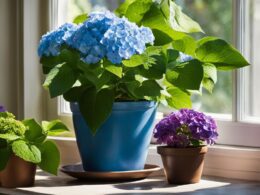Are you looking for plants that will bloom for a long time? Whether you’re a seasoned gardener or just starting out, finding plants that flower for the longest is an important consideration.
Not only do they add beauty to your outdoor space, but they also provide a source of food and shelter for pollinators like bees and butterflies.
There are many types of plants that bloom for extended periods of time, including perennials, annuals, shrubs, and trees. By understanding the characteristics of each, you can choose the best options for your garden.
With proper care and maintenance, you can also extend their bloom time, giving you even more enjoyment from your plants.
So, let’s dive in and explore which plants will bring the most color and joy to your garden for the longest amount of time.
Perennial Flowers
You’ll love learning about perennial flowers and their ability to bloom year after year! Perennial flowers are the perfect addition to any garden because they come back every season, saving you time and money. These plants have longer blooming periods than annuals and can sometimes bloom for up to six months!
To ensure your perennial flowers bloom for the longest time possible, it’s important to follow best maintenance practices. Deadheading, or removing spent flowers, is essential to keep the plant from putting energy into seed production instead of blooming. Additionally, fertilizing and watering regularly will help keep the plant healthy and strong.
Ideal growing conditions for perennial flowers include well-drained soil and full sun. Some popular perennial flowers include coneflowers, black-eyed Susans, and daylilies.
With the right care and attention, these plants can bloom for years, providing a beautiful addition to your garden. So go ahead and add some perennial flowers to your garden and enjoy their long-lasting blooms!
Annual Flowers
If you want flowers that only last one season, annual flowers are the way to go!
Petunias, marigolds, and zinnias are popular choices for annuals because they’re easy to grow and come in a variety of colors.
You can plant them in your garden or in a pot on your porch to add some color to your outdoor space.
Petunias
As you stroll through your garden, you’ll notice the vibrant and colorful petunias blooming abundantly all around you. These popular annual flowers are a favorite among gardeners for their long blooming period. With proper growing tips, you can enjoy their beauty for months on end.
Petunias come in a variety of colors, shapes, and sizes, making them a versatile choice for any garden. Some of the most popular varieties include the grandiflora, which produces large, showy flowers, and the multiflora, which produces smaller, but more numerous blooms.
To keep your petunias flowering for the longest, make sure to plant them in well-drained soil and provide them with plenty of sunlight. Deadheading, or removing spent flowers, can also help promote new growth and extend the blooming period.
With these simple tips, your garden can be awash in beautiful petunias all season long.
Marigolds
Get ready to add a pop of sunny color to your garden with marigolds, one of the longest blooming flowers out there. With their vibrant hues of yellow, orange, and red, marigolds are a popular choice for gardeners looking to add some brightness to their outdoor space.
There are many marigold varieties to choose from, including French marigolds, African marigolds, and signet marigolds, each with their own unique features and benefits.
To get the most out of your marigolds, it’s important to plant them in the right growing conditions. These flowers thrive in full sun and well-draining soil, and can tolerate a range of temperatures and climates. Water them consistently, but be careful not to overwater, as marigolds don’t like soggy soil.
With the right care, marigolds can bloom from spring to fall, making them a great choice for gardeners looking for long-lasting color. So why not give these cheerful flowers a try in your own garden?
Zinnias
You’ll love the vibrant and colorful zinnias that are coming up next in this section. These beautiful flowers are known for their long blooming period, making them a great addition to any garden.
Zinnia varieties come in a range of colors, from soft pastels to bold and bright hues. They’re an easy-to-grow annual that can thrive in a variety of conditions.
To get the most out of your zinnias, it’s important to provide them with the best growing conditions. They prefer full sun, but can tolerate some shade. They also need well-draining soil that’s rich in organic matter. Be sure to water them regularly, as zinnias don’t like to dry out.
With a little care, your zinnias will reward you with a beautiful display of flowers that will last all season long.
Are There Any Plants That Can Flower for 50 Years or More?
Yes, there are plants that can flower for 50 years or more. One such plant is the Agave Americana, commonly known as the century plant. Despite its name, this plant for 50 years actually blooms after around 25 years of growth, but the magnificent flowers can last for several months before the plant completes its life cycle.
Shrubs
Shrubs are a great option for those looking to add some color and interest to their garden throughout the seasons. They come in a variety of shapes and sizes and can even bloom during winter, making them a perfect addition to your garden.
One of the best things about shrubs is that they are drought tolerant, meaning they can withstand periods of dry weather without needing frequent watering. This makes them a low-maintenance option for those who don’t have a lot of time to spend on their garden.
Some shrubs, like the winter jasmine or the witch hazel, can even bloom during the colder months, adding some much-needed color to your garden during the winter season.
If you’re looking for a shrub that flowers for the longest period of time, you might want to consider the butterfly bush. This shrub can bloom from early summer to late fall, attracting butterflies and hummingbirds to your garden.
With its vibrant colors and long blooming period, the butterfly bush is sure to be a standout in your garden. So, if you want to add some color and interest to your garden throughout the seasons, consider planting some shrubs. They have an extended blooming period and low-maintenance nature, making them a great addition to any garden.
Trees
Now it’s time to take a look at trees – these towering beauties are the backbone of any garden and can provide shade, privacy, and a stunning focal point. Planting trees not only enhances the beauty of your garden, but it also benefits the environment.
Trees absorb carbon dioxide from the atmosphere, produce oxygen, and provide a habitat for birds and other wildlife. In addition, they can help reduce noise pollution and improve air quality.
When it comes to selecting the best tree species for different climates, it’s important to do your research. Some trees thrive in warm, tropical climates while others prefer colder temperatures. For example, the Japanese cherry blossom tree is perfect for cooler climates, while the magnolia tree thrives in warmer regions. The dogwood tree is also a popular choice for its ability to adapt to a variety of climates.
Incorporating trees into your garden can be a great investment for both your home and the environment. With so many benefits to planting trees, it’s easy to see why they are such a popular choice for gardeners of all levels.
So next time you’re planning your garden, consider adding a tree or two to create a beautiful, sustainable space that you can enjoy for years to come.
Tips for Extending Bloom Time
Extend your garden’s blooming season by following these simple tips, allowing you to enjoy a colorful and vibrant garden for an extended period of time. One way to extend the bloom time of your plants is by using cutting techniques. Deadheading or removing spent flowers can promote new growth and encourage the plant to produce more blooms.
Pruning can also help extend the bloom time by promoting branch growth and allowing more sunlight and air to reach the plant. Another tip for extending the bloom time of your plants is through fertilization methods. Fertilizing with a balanced fertilizer can encourage healthy growth and increase the number of flowers produced. However, be careful not to over-fertilize as this can lead to excessive foliage growth at the expense of flowering.
By using cutting techniques and fertilization methods, you can extend the bloom time of your plants and enjoy a beautiful and colorful garden for a longer period of time. Remember to deadhead and prune regularly and fertilize appropriately to ensure your plants are healthy and producing the most blooms possible. With these simple tips, your garden can be a source of joy and beauty for months on end.
Frequently Asked Questions
What are the best soil conditions for these long-flowering plants?
To keep your long-flowering plants thriving, it’s important to pay attention to the soil conditions. Start by monitoring the pH levels and adjusting as needed to ensure that your plants are getting the right nutrients.
Fertilization is also key, so make sure to use a high-quality fertilizer that’s appropriate for the type of plant you have.
Additionally, watering frequency is crucial – too much or too little can harm your plants. Aim to keep the soil moist but not waterlogged, and be sure to give your plants adequate sunlight exposure.
By maintaining these soil conditions, you’ll be able to enjoy beautiful, long-lasting blooms all season long.
How long does the flowering season last for each of these plant types?
When it comes to choosing plants for your garden, selecting varieties that have an extended flowering season can have many benefits. Not only do these plants provide a beautiful display of color for a longer period of time, but they also attract more pollinators to your garden.
It’s important to select the right varieties for extended blooms, as some plants may only flower for a short period of time. By doing your research and choosing plants that have a longer flowering season, you’ll be able to enjoy their beauty for much longer.
It’s also important to note that the length of the flowering season can vary between different types of plants, so it’s worth doing some research to find out how long you can expect your chosen plants to bloom.
Are there any pests or diseases that commonly affect these plants?
If you’re looking to keep your plants healthy and thriving, pest prevention and disease management are key. There are a variety of natural remedies and chemical treatments available to help keep your plants free of pests and diseases.
Some natural remedies include using companion planting, introducing beneficial insects, and using homemade sprays made from ingredients like garlic and neem oil. Chemical treatments, such as insecticides and fungicides, can also be effective but should be used with caution and following the instructions carefully.
Regular monitoring and maintenance can also help prevent and manage any potential pest or disease issues. By taking these steps, you can help ensure your plants stay healthy and strong throughout the season.
Can these plants be grown in containers or do they require a specific type of planting location?
If you’re interested in growing plants in containers, there are a few things to keep in mind. First, choose plants that are well-suited for container gardening. Some plants, like tomatoes and peppers, are great for containers, while others may not do as well.
Make sure to choose containers that are the right size for your plants, and provide adequate drainage. You’ll also want to consider the ideal climate conditions for your plants. Some plants thrive in full sun, while others prefer partial shade.
With a little bit of planning and some container gardening tips, you can enjoy beautiful, healthy plants in your home or garden.
Are there any specific pruning techniques or care requirements to ensure prolonged flowering?
To ensure prolonged flowering, it’s important to know how to care for your plants. One way to do this is through pruning. Pruning benefits your plants by removing dead or damaged branches, stimulating new growth, and improving the overall shape of the plant. It’s important to use the right tools and techniques when pruning to avoid damaging the plant.
Another important aspect of caring for your plants is fertilization techniques. By providing your plants with the right nutrients, they’ll be able to produce more blooms and have a longer flowering period. Be sure to follow the instructions on the fertilizer package and fertilize according to the plant’s specific needs.
With proper pruning and fertilization techniques, you can enjoy beautiful, long-lasting blooms from your plants.
Conclusion
Congratulations! You now know which plants flower for the longest. By choosing perennial flowers, you can enjoy blooms for several years.
Annual flowers can provide beautiful blooms for a single season, but you can extend their bloom time by deadheading or removing spent blooms. Shrubs and trees can also add long-lasting color to your garden.
To make the most out of your plant’s bloom time, try to choose plants with different flowering times. This will ensure that your garden is always in bloom. Additionally, make sure to provide your plants with proper care, including watering and fertilizing, to keep them healthy and blooming for as long as possible.
With these tips, you can have a beautiful and colorful garden that lasts throughout the season.








